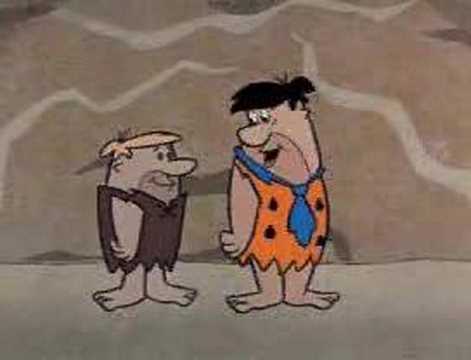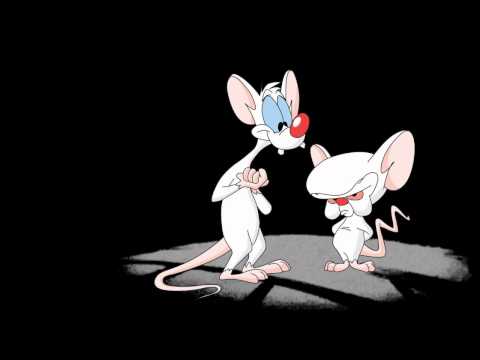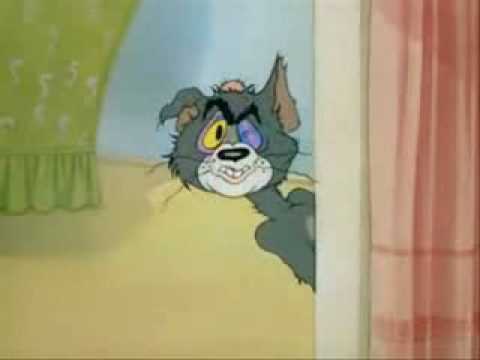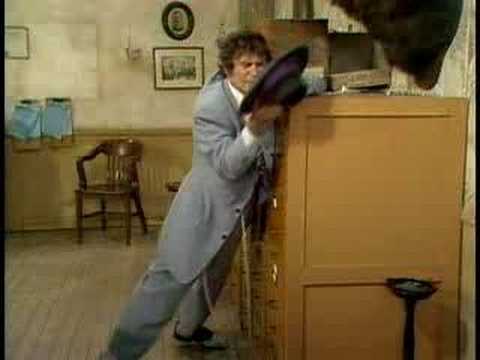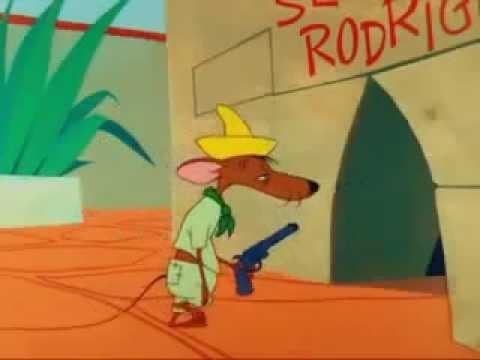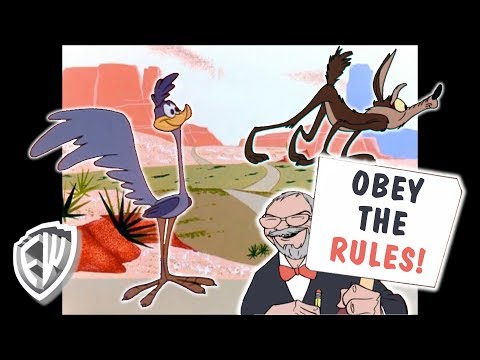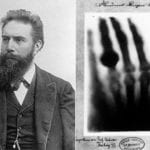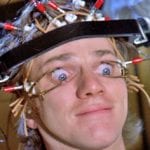10 The Flintstones Sexual Joke (That Really Isn’t)
As video clips have become easier to find on Internet video sites, people have been able to rediscover things from classic cartoons that they thought may have been off-color. The Flintstones provided one such saucy joke, a throwaway line from Barney. While arriving at a costume store, Fred remarks that perhaps Barney should get a costume with another head. Barney quips, “Another one? What do I need three of ’em for?” Get it? Because he has two, and one is his penis. Because a “head” is another name for penis. Get it? There are a few things to note. Traditionally speaking, one does not refer to a penis as a “head” in American vernacular, per se. Even this ridiculously long slang dictionary of other names for penises doesn’t have “head” listed. There is a head associated with the penis, but that’s a bit different in nomenclature, and we’re not going to spell it out for you. So what does Barney mean? The answer is much more benign—and pretty unfunny to everyone but the laughtrack. Barney is drawn “two heads high” in cartoonist-speak. Barney’s quip was simply an inside joke that only artists would catch. When it first aired, many viewers likely thought it was a joke that Barney didn’t know he only had one head (the one with the skull in it). Once the clip appeared on YouTube, everyone assumed it was a super dirty ditty from the 1960s hidden in plain sight. But it wasn’t.
9 Which Is The Genius? Which Is Insane?
The 1990s saw a resurgence of witty cartoons. One standout was Pinky and the Brain. The two titular characters got their start on the popular program Animaniacs and eventually received their own show. The premise was quite simple: Two mice plot to take over the world. As the theme song tells you, one is a genius, and the other’s insane. There’s a little catch, however. Watch this video on YouTube A few people around the Internet—and even some prior to that—realized that in the theme song, “Brain” is rhymed with “insane.” Based solely on the theme song, it seems that the genius might not be the mouse with the name to match. But there’s a lot more evidence than that, and some is obvious. Brain tries to take over the world nightly—and that alone is pretty insane. The basic structure of the show hints that Pinky is the rational one. Brain devises a plan to take over the world, Pinky points out its faults, Brain ignores him, and the plan fails. The one time Pinky comes up with his own plan in an episode cleverly entitled Pinky’s Plan, a world domination foil actually works; Pinky becomes the head of the Federal Reserve. Until (spoiler alert) Brain screws it up, that is. Everything in the show points to Pinky being the genius and Brain being insane.
8 Cartoons Integrated Long Before You Thought
Integration on network television and the introduction of non-white characters into the ensemble started slowly in the 1970s. Cartoons beat the live-action shows to the punch by adding a black character as just another member of a crime-solving crew, but the cartoon is practically forgotten today. The cartoon version of The Hardy Boys ran from 1969 to 1971. The concept was based on the famous book series, but the cartoon Hardy Boys were a band instead of brothers. One band member named Pete Jones just happened to be black. The quintet played music and solved mysteries, similarly to another famous group of teens who had a talking great dane. In a twitchin’ turn of events, the cartoon begot a real live band. That band, cleverly named The Hardy Boys, also featured a black man—the drummer, Bob Crowder. Josie and the Pussycats hit the airwaves in 1970, a year after The Hardy Boys debuted, featuring Valerie as a lead black character. The Hardy Boys is forgotten today, but kids didn’t mind that minorities were represented on the show, which facilitated other minority-driven programs like The Cosby Kids. As for Crowder, he passed away in 2013, but you’ve heard his work and didn’t even know it. He played drums on the Bee Gees track “Stayin’ Alive.”
7 Gilligan Influenced Scooby Doo
Speaking of the beloved mystery solving dog and his human gang, it is almost common knowledge that the concept of Scooby Doo came from an attempt to capitalize on the hit show The Archie Show. The original concept had five teenagers and a dog. They were in a band, naturally. So how did that idea become four teens and a dog who performed hazardous feats for manufactured dog treats? Prior to his famous run as Gilligan, Bob Denver portrayed Maynard G. Krebs on the popular show The Many Loves of Dobie Gillis (he can be seen at 5:45 in the video above). Krebs was a beatnik slacker with a goatee and a unique vernacular, just like Shaggy. Dobie, Thalia, and Zelda became the basis for Fred, Velma, and Daphne. The idea of the teens being a band fell by the wayside, but music played heavily into the scripts in the first season, notably in chase scenes. Even though they were originally based on the members of The Archies, it was Bob Denver’s other show that inspired the Scooby Doo ensemble.
6 The Pop Culture Reference No One Ever Caught
There aren’t a whole lot of people who watched Tom and Jerry during its original run reading this list. There are likely even fewer who know that Tom and Jerry is the winner of no less than seven Oscars for best animated short. The cartoons in the 1940s were timely, witty, and chock-full of sly references to everyday happenings that would have pleased both children and adults. Fast-forward to the rerun days of Tom and Jerry from the 1970s to the present. Some of those cutesy pop culture jokes are lost to the audience. In two Tom And Jerry cartoons, Tom says while deadpanning and breaking the fourth wall, “Don’t you believe it.” It’s funny because something just blew up, a good enough reason to laugh for present-day viewers. But if you think about it, why does the voice sound like that? Its origin is a pop culture reference from that era. In 1947, a radio show entitled Don’t You Believe It debunked myths and cleared up mistruths. And the catchphrase of Don’t You Believe It? You won’t believe it, but it was “Don’t you believe it!” You can see why Tom and Jerry was so popular at the time—it was funny to the kids and the adults, which is the true mark of an entertaining cartoon.
5 The Ghostbusters Cartoon Copycat Isn’t The One You Think
A funny thing happened in the 1980s. In an effort to cash in on the hit movie Ghostbusters, a cartoon with the same name popped onto television screens, which forced a cartoon that was actually based on the movie to be called The Real Ghostbusters instead. How did some unknown cartoon win out? It all started in a more peaceful time: the 1970s. It was an innocent era when television executives thought they could put live-action programming on Saturday mornings for kids to watch. The Ghost Busters featured two bumbling ghost detectives and their gorilla named Tracy as they tracked down ghosts and goblins in castles. It was always castles. The show didn’t click with viewers, and it only lasted a season. But Filmation did retain the name. When Columbia Pictures wanted to use the name “Ghostbusters” for their hit movie, they paid Filmation for the rights to the name. This is where things get squirrelly. Either Filmation didn’t receive what they thought, or they didn’t receive the rights to produce a cartoon based on the film regardless of the name. Columbia moved on to create a cartoon and didn’t use Filmation. That’s when Filmation decided to revamp their 1970s live-action show as a cartoon with the name Ghostbusters. An out-of-court settlement awarded the name Ghostbusters to Filmation. The sons of Spenser and Kong (the original live-action duo) busted ghosts with Tracy the gorilla, and the cartoon based on the hit movie was rebranded as The Real Ghostbusters. So, The Real Ghostbusters based on the movie is the copycat, and the Ghostbusters based on the television show you never heard of is part of the original franchise. Confused? You should be. And to make matters worse, Ghostbusters—the one based on the failed television show—lasted less than a year in daytime syndication. The Real Ghostbusters lasted for six seasons.
4 Slowpoke Rodriguez Became A Victim Of Political Correctness
Someone who didn’t reinforce a positive portrayal was Speedy’s cousin, Slowpoke Rodriguez. As his name suggests, he’s a cousin from his Speedy’s mother’s side. Also suggested by the name, he’s very slow. His shuffling feet and slurred speech draws imagery of the slack-jawed stoner. He even sings “La Cucaracha”—the cockroach. “Roach” is slang for a marijuana cigarette (you knew that). And on top of the stoner portrayal, Slowpoke Rodriguez had a secret defense to stop cats accosting him: He was armed. Cartoon Network kept Slowpoke in, but edited the ending to remove the shooting.
3 The Road Runner Rules
If there’s any cartoon that you’d think wouldn’t take itself too seriously, it would be one where a roadrunner is chased by a coyote—and that’s all. From the silly Latin names describing the creatures to the blatant disregard for all the hard work of Sir Isaac Newton, the Wile E. Coyote and the Road Runner cartoons seem to be sillier than focused. But there’s a reason the show worked; it followed a very strict guideline. Chuck Jones was the genius who created Wile E. Coyote and his archnemesis, the Road Runner. Jones took his craft quite seriously and wanted to make sure that it wasn’t simply havoc that dictated the capers. Animators and scripts followed very specific rules that created an environment that made the show so successful. Some are simple; the action is contained in the American Southwest, where the animals do reside in real life. Others are simply brilliant when you think of how the show unfolds. For one, the Road Runner never directly harms the Coyote. This is different from most cartoons of the era when either protagonist could inflict harm. The Coyote is only harmed by his own ineptitude or the failure of his elaborate traps. Another rule is that all devices must be ordered from Acme Products. Most importantly, gravity is the greatest foe of the Coyote whenever possible. When you think of the rules and how they play into the show, the restrictions cause the brilliance that has made the show endure the test of time.
2 SpongeBob Is At The Bottom Of A Nuclear Testing Site
Stephen Hillenburg’s quirky cartoon about a sponge and his starfish friend took the world by storm in 1999. The quirky world of Spongbob Squarepants, the sponge who lives in a pineapple under the sea with an eclectic cast of ocean creatures, has a well-developed concept origin. Hillenburg came up with the idea while he was working on a cartoon called Rocco’s Modern Life. It was Hillenburg’s oceanic knowledge—he previously worked for the Ocean Institute—that helped solidify the iconic character. It’s not a stretch to see that the ensemble of Spongebob Squarepants is based on real animals, but is Bikini Bottom based on a real place? If there’s a place called Bikini Bottom, it only makes sense that there must also be a Bikini Top. That would be the island above the surface where Spongebob and his mates reside. The prevailing theory is that above Bikini Bottom is the Bikini Atoll. If that sounds familiar, it should; that’s where the United States tested nuclear weapons in the 1940s. It would make a lot of sense in the world of radioactive city-destroyers (thank you Godzilla) that Spongebob and his posse are the way they are thanks to good old-fashioned radioactive mutation. The theory has been out there since the show started and is accepted by the fans as fact today. Hillenburg has not confirmed the theory yet, but there’s a lot of circumstantial evidence out there—every explosion that happens in the cartoon takes the shape of a mushroom cloud.
1 Jane Jetson Was A Teen Mom
The beloved futuristic family on The Jetsons has been previewing the days to come since 1962. The show premiered at the same time as its counterpart, The Flintstones. The Jetsons was essentially The Flintstones set in the future with older kids and a dog instead of a dinosaur. But unlike The Flintstones, The Jetsons failed as a prime time program, lasting only a season before finding its popularity as a Saturday morning cartoon. If people had paid closer attention, they might have realized that Jane Jetson could’ve been on a controversial MTV show. In the premiere episode of The Jetsons, Jane Jetson, matriarch of the family, declares that she is “only 33.” It’s a throwaway line really, just meant to show that she’s out of touch with her teen daughter. There’s a problem: She has a teenaged daughter. Judy is 16. That means that Jane Jetson had Judy when she was 17. That explains the 10-year gap between kids; her boy Elroy is only six. But wait, there’s more! George Jetson is 40, which means he was 24 when he fathered a child with an underage girl. In a lot of places, that’s considered statutory rape under the law. Nothing in the show ever hinted that George was Judy’s stepfather, so if he is her birth father, he’s got a lot of explaining to do. Jake wrote a trivia e-book filled with crazy stuff like the kind you just read in this list. You can follow him on twitter for more useless facts.
